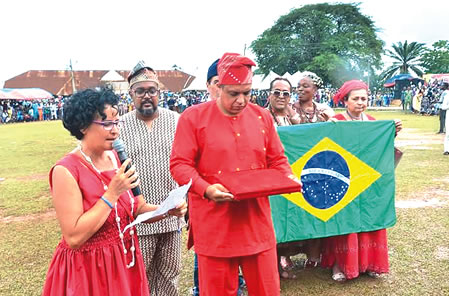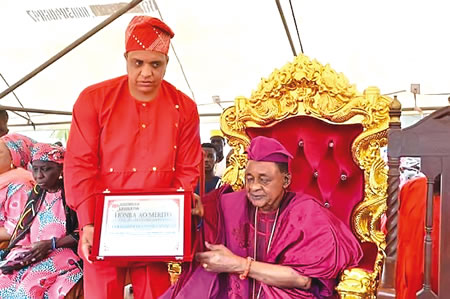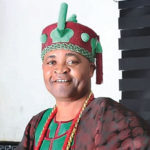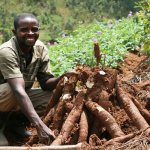On their seats where they were following series of cultural performances with rapt attention, their different Yoruba attires on their white skin were an attraction to the indigenes who gazed them longingly and with amazement.
Their total disposition to the songs, dances and acrobatic displays was indicative of their passion for Yoruba culture and tradition. They were the foreign tourists who travelled down from Brazil in South America and witnessed the grand finale of 2008 Sango Festival at the festival arena in the palace of the Alaafin of Oyo, Oba Olayiwola Adeyemi last Saturday.
The Brazilians left no one in doubt of their strong connection with the festival as they did not only spectate but also formally paid homage to the Alaafin amidst ovation. They also presented the monarch with a tribute, after which one of them, Mr Denilson Cordeiro Monteiro delivered a speech.
In the speech read in tongue-tied English Language, the representative of the Legislative Assembly in Clelia Gomes-Sao Paulo refreshed the memory of Oba Adeyemi of his visit to Brazil in 2014 during which he demonstrated in actions, words and outlook the rich Yoruba culture.
Other members of the delegate included Renata Barcelos, Flavio Paula, Mauricio Condrad, Leoni Ramos and Flavio Monteiru. Unable to suppress their emotions, they accompanied the Alaafin to the palace where they further expressed their joy in meeting and listening to Oba Alaafin’s message to the Yorubas at home and in the diaspora.
The traditional ruler, who spoke both in Yoruba and English Language in that order, warned the Yorubas of the hovering danger in losing their culture, especially language to the foreigners, who, according to him, had not hidden their mission to incorporate Yoruba Language into their life.
In the US, he revealed, about 26 universities currently offer Yoruba Language as a course of study with a sign that other universities would follow suit in the nearest future, lamenting that if the Yorubas continue their indifferent attitude to the language and culture as a whole, the white would come and teach them the language.
“There is another evidence to support this. In June 1999 when I visited the US, the drummers who entertained us at the airports were all Americans. I looked at them and shook my head in sympathy for our people back home,” he said.
Oba Adeyemi used the presence of large crowd to warn criminal elements in the town to desist from the acts or risk being handed over to the law enforcement operatives.
While he patted the Oyo Mesi, the Baales and chiefs in the back for their support, he however, charged them to always be on top of security situation of their communities and quarters to enjoy enduring peace, reminding them of their responsibility as peace promoters of their respective immediate environments.
“It is not good news that some youths have embraced crimes as means of livelihood, using public gatherings such as carnival and other social functions as cover up. I am not against the youths creating time to socialize among themselves but I can’t be here in the palace to watch the youths breaking law with impunity.
“I am telling you baales and chiefs to work together with the police in combating crimes. Whoever is caught should be taken to the police. My past efforts have attracted noise that Alaafin was keeping private security outfit. That is why I am urging you to use the police when necessary,” he said.
Though a culture festival, its social content was seen in the wives of Oba Adeyemi all of whom clad in pink Ankara fabric and seated beside the traditional ruler.
Different cultural troupes, including Danafojura masquarede and Asabi Oje staged scintillating performances to the amusement of the teeming crowd who converged on the venue. Danafojura, popularly known as the Alaafin’s masquerade, stood out with its magical prowess in which he danced inside burning fire made by its followers. He did that more than five times and earned wild ovation for coming out of the fire unscathed.
In her speech, which elicited laughter when she made efforts to pronounce the names of Oba Adeyemi, Ibe promised the audience of the NTDC readiness to promote culture of Nigerian ethnic groups with a view to showcasing them to foreigners at international fora.
“What I have seen here today is second to none. It is not because I am attending this festival for the first time; it is because the performances are real and very interesting. I am appreciating the Alaafin for preserving our cultural heritage. We shall continue to be here to reconnect with our past,” she said.
Another cynosure of all eyes at the festival was Dr Paula Gomez, who was the director of the organization of Sango World Festival. A Portuguese, Gomez arguably is what the late Adunni Olorisa, Suzan Wenger was to Osun Osogbo by her act and passion with which she went about the arrangement.
Her strength in effectively coordinating committees produced the result which swept Mrs Ibe and other tourists at the event off the carpet. Gomez told Nigerian Tribune that she had no choice than to stage a standard festival for the sake of the image of the Alaafin and Oyo regarded as home of Yoruba cultural renaissance.
“Not being a Nigerian does not remove the fact from my love for Yoruba culture. And I have found a great support in baba Alaafin who would always guide me on what I need to know. I am using this opportunity to tell the Yorubas that this culture must not die. It is rich and a great product to sell to the world. I am very proud to associate with the culture, hence my active involvement. I am assuring you that next edition in 2019 will be better. I am thanking all those who joined hands with me in staging this, including you,” she said.







